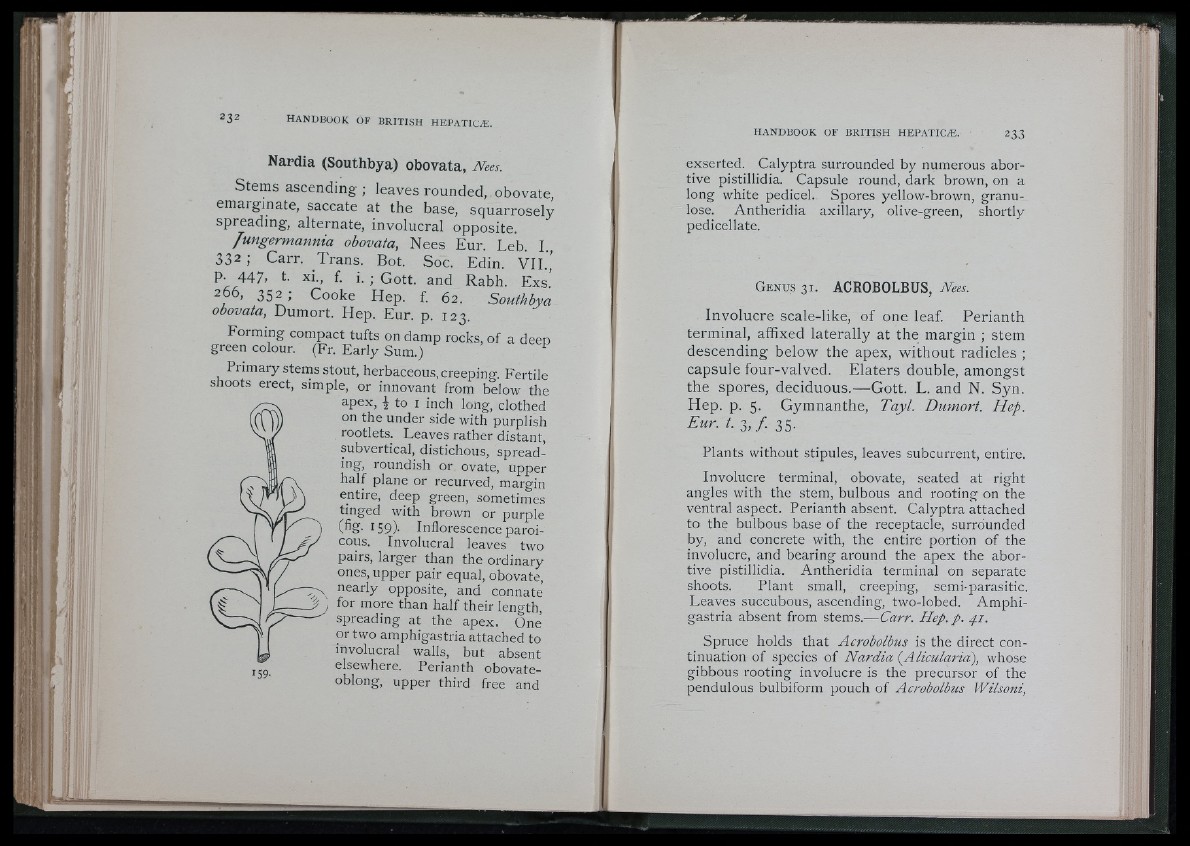
Nardia (Southbya) obovata, Nees.
Stems ascending ; leaves rounded, obovate
emarginate, saccate at the base, squar rosely
spreading, alternate, involucral opposite.
Jungermannia obovata, Nees Eur. Leb. I.,
3 3 2 ; Carr. Trans. Bot. Soc. Edin. V l T
P- 4 4 7 . t. xi., f. i. ; Gott. and Rabh. Exs!
266, 352 ; Co o ke Hep. f. 62. Southbya
obovata, Dumort. Hep. Eur. p. 123.
Forming compact tufts on damp rocks, of a deep
green colour. (Fr. Early Sum.)
Primary sterns stout, herbaceous, creeping. P'ertile
shoots erect, simple, or innovant from below the
apex, 4 to I inch long, clothed
on the under side with purplish
rootlets. Leaves rather distant,
subvertical, distichous, spreading,
roundish or ovate, upper
half plane or recurved, margin
entire, deep green, sometimes
tinged with brown or purple
(fig’ 159)’ Inflorescence paroicous.
Involucral leaves two
pairs, larger than the ordinary
ones, upper pair equal, obovate,
nearly opposite, and connate
for more than half their length,
spreading at the apex. One
or two amphigastria attached to
involucral walls, but absent
elsewhere. Perianth obovate-
oblong, upper third free and
exserted. Calyptra surrounded by numerous abortive
pistillidia. Capsule round, dark brown, on a
long white pedicel. Spores yellow-brown, granulose.
Antheridia axillary, olive-green, shortly
pedicellate.
G e n u s 3 1 . ACROBOLBUS,
Involucre scale-like, of one leaf. Perianth
terminal, affixed laterally at the margin ; stem
descending be low the apex, without radicles ;
capsule four-valved. Elaters double, amongst
the spores, deciduous.— Gott. L. and N. Syn.
Hep. p. 5. Gymnanthe, Tayl. Dumort. Hep.
E ur . t . z , f Z S -
Plants without stipules, leaves subcurrent, entire.
Involucre terminal, obovate, seated at right
angles with the stem, bulbous and rooting on the
ventral aspect. Perianth absent. Calyptra attached
to the bulbous base of the receptacle, surrounded
by, and concrete with, the entire portion of the
involucre, and bearing around the apex the abortive
pistillidia. Antheridia terminal on separate
shoots. Plant small, creeping, semi-parasitic.
Leaves succubous, ascending, two-lobed. Amphigastria
absent from stems.— Carr. Hep. p. 41.
Spruce holds that Acrobolbus is the direct continuation
of species of Nardia {Alicularia), whose
gibbous rooting involucre is the precursor of the
pendulous bulbiform pouch of Acrobolbus Wilsoni,